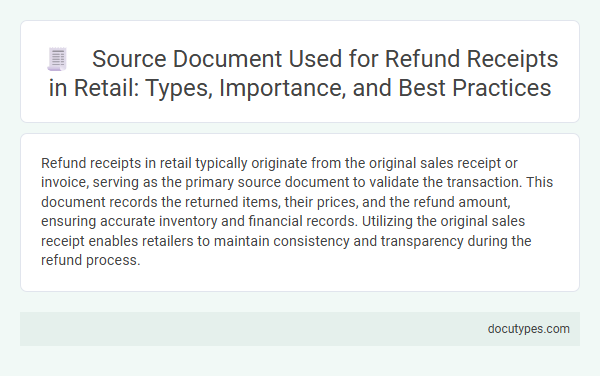Refund receipts in retail typically originate from the original sales receipt or invoice, serving as the primary source document to validate the transaction. This document records the returned items, their prices, and the refund amount, ensuring accurate inventory and financial records. Utilizing the original sales receipt enables retailers to maintain consistency and transparency during the refund process.
Introduction to Source Documents in Retail Refunds
Source documents play a crucial role in processing refund receipts in retail. Understanding these documents ensures accurate transaction records and smooth customer service.
- Refund Receipt - Acts as proof of a returned item and the amount refunded to the customer.
- Original Sales Receipt - Serves as the primary reference to validate the original purchase details during a refund.
- Credit Memo - Used to authorize and document credit issued back to Your account or payment method after a return.
Definition and Purpose of Refund Receipt Source Documents
A refund receipt source document in retail is a record that verifies the return of goods and the reimbursement issued to the customer. This document serves as proof of the transaction reversal and details the items returned, date, and refund amount.
The primary purpose of a refund receipt source document is to maintain accurate financial records and ensure transparency during the refund process. It helps retailers track returned merchandise, prevent fraud, and reconcile inventory levels. Customers use this receipt as evidence of the refund for their records and potential future inquiries.
Common Types of Source Documents for Refunds
Source documents for refund receipts in retail serve as proof of the original transaction and validate the refund process. These documents ensure accurate record-keeping and help prevent fraudulent returns.
Common types of source documents for refunds include original sales receipts, credit card transaction slips, and digital invoices. These documents provide essential details like purchase date, item description, payment method, and transaction amount.
Key Information Included in Refund Receipts
The source document used for refund receipts in retail is typically the original sales receipt or invoice. This document serves as proof of purchase and validates the refund process.
- Transaction Date - Indicates when the original purchase was made to confirm eligibility for a refund.
- Item Description - Details the specific product or service being returned for accurate record-keeping.
- Refund Amount - Specifies the exact sum reimbursed to the customer based on the returned items.
Your refund receipt ensures transparency and provides a formal record for both the retailer and customer.
Importance of Accurate Source Documentation in Refunds
| Source Document for Refund Receipts in Retail |
|---|
| A refund receipt in retail is typically generated based on the original sales receipt or invoice. This source document contains critical transaction details such as the item description, quantity, price, purchase date, and payment method. When processing a refund, the sales receipt serves as the primary reference to verify the legitimacy of the return and to ensure correct refund amounts. |
| Importance of Accurate Source Documentation |
| Accurate source documentation plays a vital role in maintaining the integrity of refund transactions. Precise records help prevent errors, reduce fraudulent returns, and enable effective inventory management. Clear tracking through original receipts supports financial auditing and tax compliance, safeguarding your retail operations. Ensuring that refund receipts are backed by correct and verifiable source documents leads to smooth customer service and reliable accounting processes. |
Legal and Compliance Considerations
In retail, refund receipts are typically generated using the original sales invoice or transaction receipt as the source document. This practice ensures legal compliance by providing verifiable proof of the returned goods and the refund amount. Accurate documentation through these source documents helps meet regulatory requirements and supports audit trails for financial accountability.
Best Practices for Managing Refund Receipt Documents
In retail, the primary source document used for refund receipts is the original sales receipt. This document verifies the purchase details necessary to process the refund accurately.
Best practices for managing refund receipt documents include maintaining organized digital and physical records to ensure quick retrieval. Implementing a clear refund policy and training staff on proper documentation helps prevent disputes and enhances customer trust.
Digital vs. Paper Refund Receipt Source Documents
What source document is used for refund receipts in retail? Refund receipts in retail commonly use either digital or paper source documents. Digital refund receipts offer instant record-keeping and easy access, while paper receipts provide a tangible proof of transaction.
Challenges in Handling Refund Documentation
In retail, the primary source document used for refund receipts is the original sales receipt, which serves as proof of purchase and validates the refund transaction. Challenges in handling refund documentation include verifying the authenticity of the original receipt, preventing fraudulent returns, and ensuring accurate record-keeping for accounting purposes. Your business must implement strict policies and reliable documentation systems to minimize errors and maintain financial integrity.
What Source Document Is Used for Refund Receipts in Retail? Infographic

